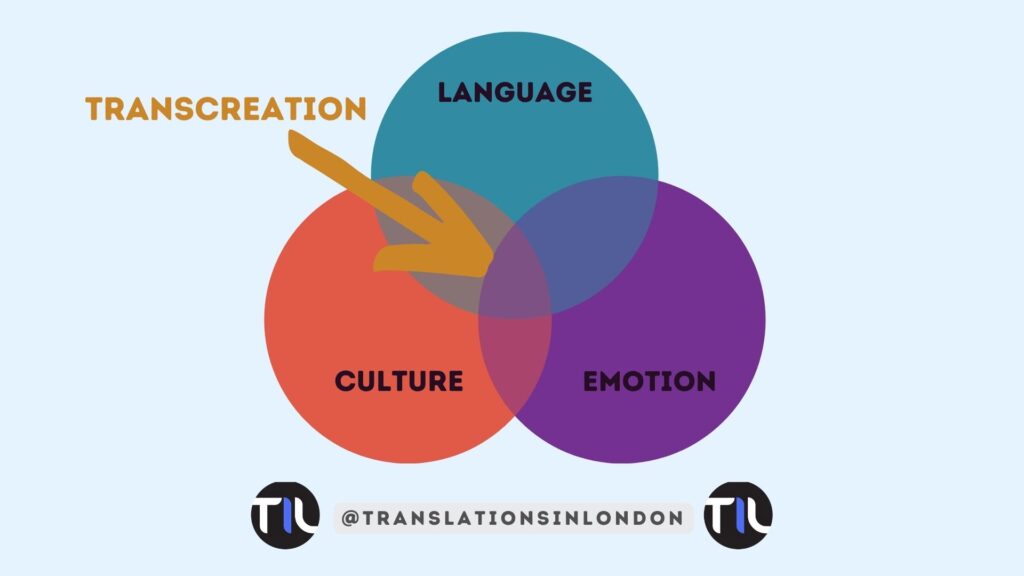Translation scholar Elsa Figueroa defines “transcreation” as a process in which the translator is “given permission” by the formulator of the request to create a new text that could be considered equivalent to the source text, insofar as it produces the same or a similar effect on the target locale’s audience as it would on the source text’s target audience.
As she pointed out in her article, “Transfixed: Challenges of Text-Focused Translation in a Visual Age,” any translation of the slogan “Just Do It!” has to encourage consumers to engage in some form of athletic activity. However, to achieve this, translators must take into account the cultural values of the people they are selling to. This slogan works in America due to its “can-do” attitude and American spirit. Figueroa emphasises that not all cultures share the same perspective. She goes on to say, “the translator would rather need to find an appropriate combination of words that together with the accompanying visuals would motivate the viewer in the same way as the source language audience is [motivated] by the piece of advertising.

The Role of Marketing
We live in a consumerist world; a world where people know what they want and how to get it. In this competitive society, where multiple companies battle it out to sell their products and their brands, they need something that will set them apart from the rest. This is where marketing comes in. One of the most important tools in the marketing toolbox is the tagline or the slogan (the former a brief phrase which sums up the company, the latter a phrase used with marketing campaigns by the company that often changes). It helps sell products by making people take notice; it’s catchy, memorable, and inspiring. “Just Do It!”, “Every Little Helps”, “I’m Lovin’ It” and “Because You’re Worth It.” are just some famous examples. As they say, the pen is mightier than the sword. But how do you make your translated tagline mighty?
For a translated tagline to reach its potential, a high level of cooperation between the translation team and the client is required. This is where the experienced project management of a translation company comes into play. Here at TIL, we work closely with native translators to ensure a tagline is localised. It may only be a few words long, but it is often built out of wordplay or specific cultural elements alien to a target culture and language – these elements require consideration and debate. This is where creativity on the translator’s part is essential, but not to the extent that the message is totally changed; the new tagline has to work in the same “want-remember-buy” trifecta as the original.
The Cost of Poorly Translated Slogans
Many companies spend millions creating innovative and eye-catching campaigns in their primary markets, but then squander their well-spent money when they fail to consider localisation techniques for an international launch. A poorly translated slogan or tagline can cost a company its pride and reputation. A tagline should instil confidence in a brand, encourage people to make purchases, and keep them coming back for more, rather than subjecting the company to ridicule, turning it into a laughingstock.
Five of the worst examples to date:
- English>Chinese: ‘’Come Alive: You’re in the Pepsi Generation’’ became ‘’Pepsi brings your ancestors back from the dead’’.
- English>Spanish: ‘’Got Milk?’’ translated in Mexico was ‘’Are you lactating?’’.
- English>Spanish: ‘’Suffer from diahorrea with Coors’’ was the translation of ‘’Turn it loose’’.
- English>Spanish: ‘’Fly in Leather’’ became ‘’Fly Naked’’ for American Airlines.
- English>Spanish: Frank Purdue’s ’’It takes a tough man to make a tender chicken’’ was turned into ‘’It takes a sexually stimulated man to make an affectionate chicken’’.
Five of the best:
- English>Spanish: ‘’Me encanta’’, McDonald’s ‘’I’m Lovin’ It’’.
- English>Spanish: ‘’Vívela’’, Coca-Cola’s ‘’Enjoy’’ which means ‘’Live it’’.
- English>Spanish: ‘’Desde el 1886 repartiendo felicidad’’, Coca-Cola’s ‘’Live it Light’’ which means ‘’Spreading Happiness Since 1886’’, the word for ‘light’ in Spanish not having any double meaning.
- English>Spanish: ‘’En Orange, estamos para ayudarte’’, Orange’s ‘’The Future’s Bright, The Future’s Orange’’ which means ‘’At Orange, we’re here to help’’. Not so catchy but a literal translation wouldn’t work as the company is not called ‘naranja’, the Spanish word for orange.
- English>French: ‘’Chaque jour c’est du Bonheur à tartiner’’, Nutella’s ‘’Breakfast Never Tasted This Good’’ which means ‘every day it’s a joy to spread’.
Address your Target Culture
In this era of globalisation, we must encourage translators to develop new skills and have a thorough understanding of both source and target cultures. That’s why working with native speakers of the target language is indispensable; it’s the only way to ensure that a tagline or slogan has the same impact on its target audience as it did on its source audience. To meet the challenges posed by our consumerist globalised world, we must educate both translators and clients about the significance of collaborative efforts in crafting a slogan that resonates with the culture it’s intended for. It’s all about a symbiotic relationship between the client and the agency, the agency and the translator, and ultimately, the source text and the target text.
In conclusion, for effective global marketing, a well-localised slogan is crucial. At TranslationInLondon (TIL), we understand that transcreation involves more than just translation – it’s about cultural sensitivity, creativity, and teamwork.
Choose TIL for expert linguistic content and project management in localisation. Contact us to unleash the potential of your global marketing campaigns.
For more information: Figueroa, Elsa (forthcoming 2014), ‘Transfixed: Challenges of Text-Focused Translation in a Visual Age’ in Norwich Papers, 21.